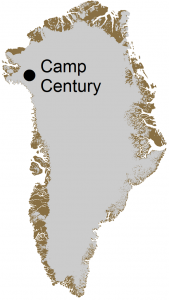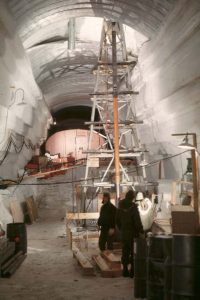4 August 2016
WASHINGTON, DC — Climate change could remobilize abandoned hazardous waste thought to be buried forever beneath the Greenland Ice Sheet, new research finds.
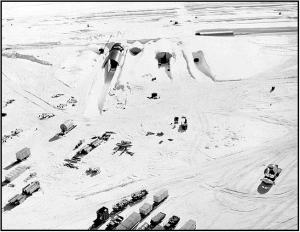
The northeast portal to Camp Century during construction in 1959. New research shows the camp’s waste could remobilize by 2090.
Credit: US Army.
Camp Century, a U.S. military base built within the Greenland Ice Sheet in 1959, doubled as a top-secret site for testing the feasibility of deploying nuclear missiles from the Arctic during the Cold War. When the camp was decommissioned in 1967, its infrastructure and waste were abandoned under the assumption they would be entombed forever by perpetual snowfall.
But climate change has warmed the Arctic more than any other region on Earth, and a new study finds the portion of the ice sheet covering Camp Century could start to melt by the end of the century. If the ice melts, the camp’s infrastructure, as well as any remaining biological, chemical and radioactive waste, could re-enter the environment and potentially disrupt nearby ecosystems, according to the study’s authors.
Determining who is responsible for cleaning up the waste could also lead to political disputes not considered before, according to the study’s authors.
“Two generations ago, people were interring waste in different areas of the world, and now climate change is modifying those sites,” said William Colgan, a climate and glacier scientist at York University in Toronto, Canada, and a research associate at the Cooperative Institute for Research in Environmental Sciences (CIRES) in Boulder, Colorado, lead author of the new study. “It’s a new breed of political challenge we have to think about.”
The new study was published today in Geophysical Research Letters, a journal of the American Geophysical Union.
The assumption that any waste could be buried forever under ice is unrealistic, according to James White, a climate scientist at the University of Colorado in Boulder, who was not connected to the study.
“The question is whether it’s going to come out in hundreds of years, in thousands of years, or in tens of thousands of years,” White said. “This stuff was going to come out anyway, but what climate change did was press the gas pedal to the floor and say, ‘it’s going to come out a lot faster than you thought.’”
A “city under the ice”
During the Cold War, U.S. military attention shifted to the Arctic — the shortest route between the U.S. and the former Soviet Union. In April 1951, the U.S. and Denmark agreed to defend Greenland, a Danish territory, from Soviet attack, and the U.S. built several air bases in Greenland that year.
In 1959, the U.S. Army Corps of Engineers built Camp Century 200 kilometers (125 miles) inland from the Greenland coast. Encased completely within the ice sheet, Camp Century became known as the “city under the ice.”
The camp’s official purpose was to test construction techniques in the Arctic and conduct scientific research. While in operation, the camp housed 85 to 200 soldiers and was powered by a nuclear reactor. Scientists at Camp Century took ice core samples providing climate data still cited in research today, Colgan said.
The camp also provided proof of concept for a top secret program to test the feasibility of building nuclear missile launch sites close enough to reach the Soviet Union. While never built, a larger planned camp based on the concept of Camp Century would have housed a 4,000-kilometer (2,500-mile) long tunnel system underneath the ice, capable of deploying up to 600 nuclear missiles.
Although the camp was built with Denmark’s approval, the missile launch program, known as Project Iceworm, was kept secret from the Danish government. Several years after the camp became operational, Project Iceworm was rejected by the Joint Chiefs of Staff and the camp was decommissioned. The Army Corps of Engineers removed the nuclear reaction chamber but left the camp’s infrastructure and all other waste behind, assuming the ice sheet would secure them forever. In the decades since, falling snow has buried the camp roughly 35 meters (115 feet) further underneath the ice.
Waste beneath the ice
In the new study, Colgan and his team took an inventory of the wastes at Camp Century and ran climate model simulations to determine whether the waste will stay put in a warming Arctic. The team analyzed historical U.S. army engineering documents to determine where and how deep the wastes were buried and how much the ice cap had moved since the 1950s.
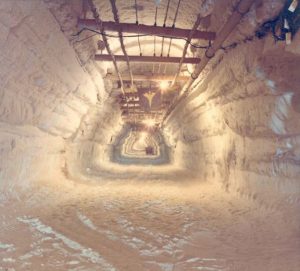
A view inside the main 400-meter (1,300-foot) access trench to Camp Century in 1964. More than 12 150-meter (500-foot) long side trenches radiated out from the main trench.
Credit: US Army.
The team found the waste at Camp Century covers 55 hectares (136 acres), roughly the size of 100 football fields. They estimate the site contains 200,000 liters (53,000 gallons) of diesel fuel, enough for a car to circle the globe 80 times. Based on building materials used in the Arctic at the time, the authors speculate the site contains polychlorinated biphenyls (PCBs), pollutants toxic to human health. They also estimate the site has 240,000 liters (63,000 gallons) of waste water, including sewage, along with an unknown volume of low-level radioactive coolant from the nuclear generator.
Looking at existing business-as-usual climate projections, the team determined the wastes would not remain encased in ice forever, as was assumed by both the U.S. and Denmark when the camp was abandoned. Instead, they could melt and re-enter the environment.
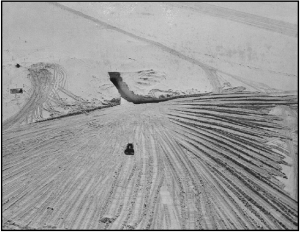
The northeast portal to Camp Century in 1964, shortly before the base was abandoned.
Credit: US Army.
“When we looked at the climate simulations, they suggested that rather than perpetual snowfall, it seems that as early as 2090, the site could transition from net snowfall to net melt,” Colgan said. “Once the site transitions from net snowfall to net melt, it’s only a matter of time before the wastes melt out; it becomes irreversible.”
Camp Century’s waste presents a significant environmental hazard, according to the study’s authors. When the ice melts, pollutants could be transported to the ocean, where they could disrupt marine ecosystems, Colgan said.
Based on ice sheet observations near Camp Century but at lower elevations, the camp’s waste could be exposed sooner than the study’s models predict, said Jennifer Mercer, a cryospheric scientist with the National Science Foundation who specializes in operations on the Greenland Ice Sheet and who was not connected to the study.
Environmental, political implications
The study does not advocate for starting remediation activities at Camp Century now. The waste is buried tens of meters below the ice, and any cleanup activities would be costly and technically challenging, Colgan said.
“It really becomes a situation of waiting until the ice sheet has melted down to almost expose the wastes that anyone should advocate for site remediation,” he said.
But the new study does raise questions about who is responsible for cleaning up the waste when it is exposed. International law is clear about responsibility for preventing future hazardous waste, but ambiguous about who is liable for waste already discarded, said Jessica Green, a political scientist specializing in international environmental law at New York University who was not connected to the study. Although Camp Century was a U.S. base, it is on Danish soil, and although Greenland is a Danish territory, it is now self-governing, she said.
The implications of climate change on politically ambiguous abandoned wastes have not been considered before, according to the study’s authors.
“The study identifies a big hole in the extant set of laws and rules we have to deal with environmental problems globally,” Green said.
###
The American Geophysical Union is dedicated to advancing the Earth and space sciences for the benefit of humanity through its scholarly publications, conferences, and outreach programs. AGU is a not-for-profit, professional, scientific organization representing more than 60,000 members in 139 countries. Join the conversation on Facebook, Twitter, YouTube, and our other social media channels.
Notes for Journalists
This research article is open access. A PDF copy of the article can be downloaded at the following link: http://onlinelibrary.wiley.com/doi/10.1002/2016GL069688/pdf
Journalists and PIOs may also order a copy of the final paper by emailing a request to Lauren Lipuma at [email protected].
Please provide your name, the name of your publication, and your phone number.
Neither the paper nor this press release is under embargo.
“The abandoned ice-sheet base at Camp Century, Greenland, in a warming climate”
Authors:
William Colgan: Lassonde School of Engineering, York University, Toronto, Canada, and Cooperative Institute for Research in Environmental Sciences, University of Colorado, Boulder, Colorado, U.S.A.;
Horst Machguth: Department of Geography, University of Zurich, Switzerland, and Department of Geosciences, University of Fribourg, Switzerland;
Mike MacFerrin: Cooperative Institute for Research in Environmental Sciences, University of Colorado, Boulder, Colorado, U.S.A.;
Jeff D. Colgan: Watson Institute for International and Public Affairs, Brown University, Providence, Rhode Island, U.S.A.;
Dirk van As: Department of Glaciology and Climate, Geological Survey of Denmark and Greenland, Copenhagen, Denmark;
Joseph A. MacGregor: Cryospheric Sciences Laboratory, NASA Goddard Space Flight Center, Greenbelt, Maryland, U.S.A.
Contact Information for the Authors:
William Colgan: [email protected], +1 (416) 736-2100, extension 77703
Jeff D. Colgan: [email protected], +1 (401) 863-9721
Lauren Lipuma
+1 (202) 777-7396
[email protected]
CIRES Contact:
Katy Human
+1 (303) 735-0196
[email protected]
York University Contact:
Sandra McLean
+1 (416) 736-2100, extension 22097
[email protected]
Watson Institute Contact:
Kathryn Dunkelman
+1 (401) 863-1302
[email protected]
